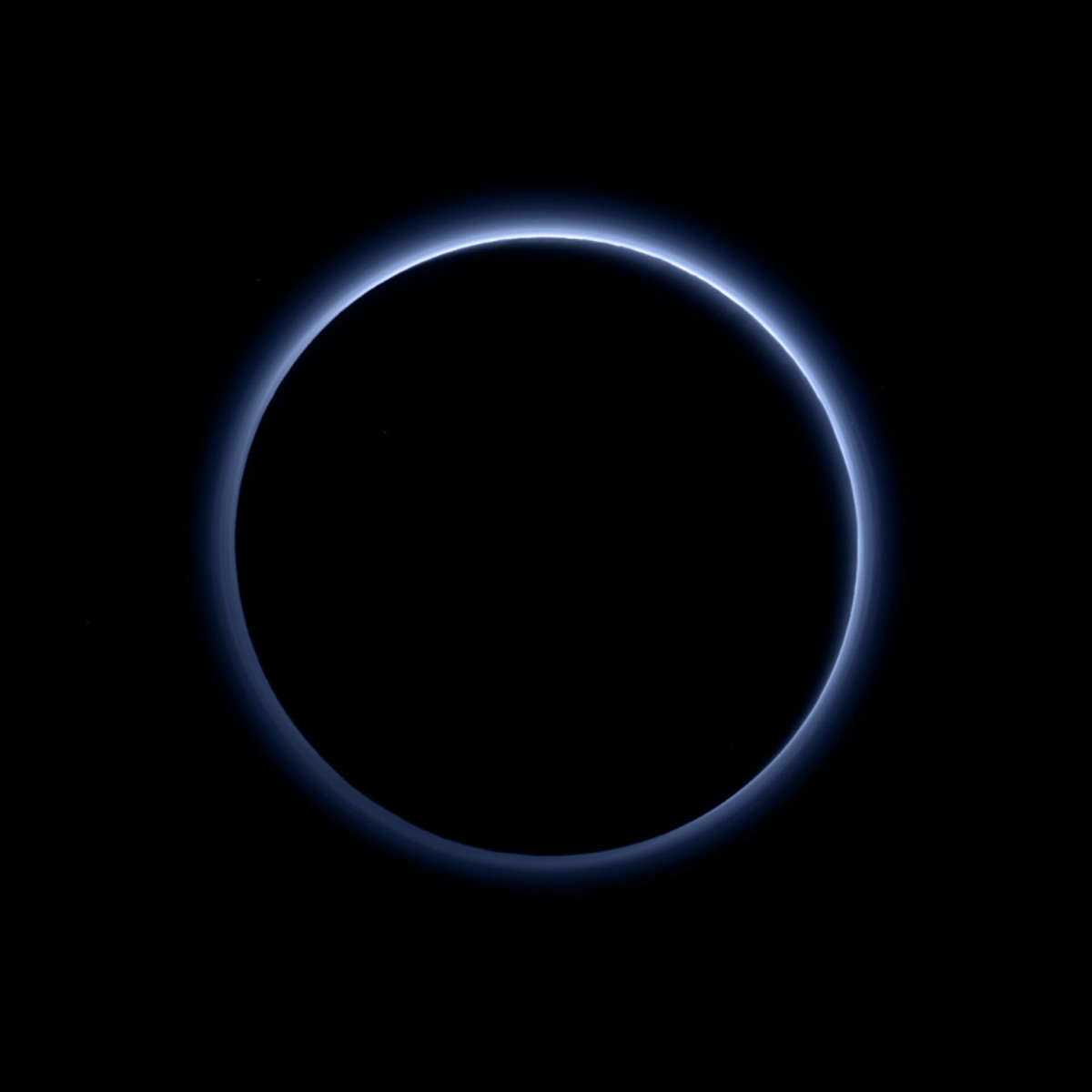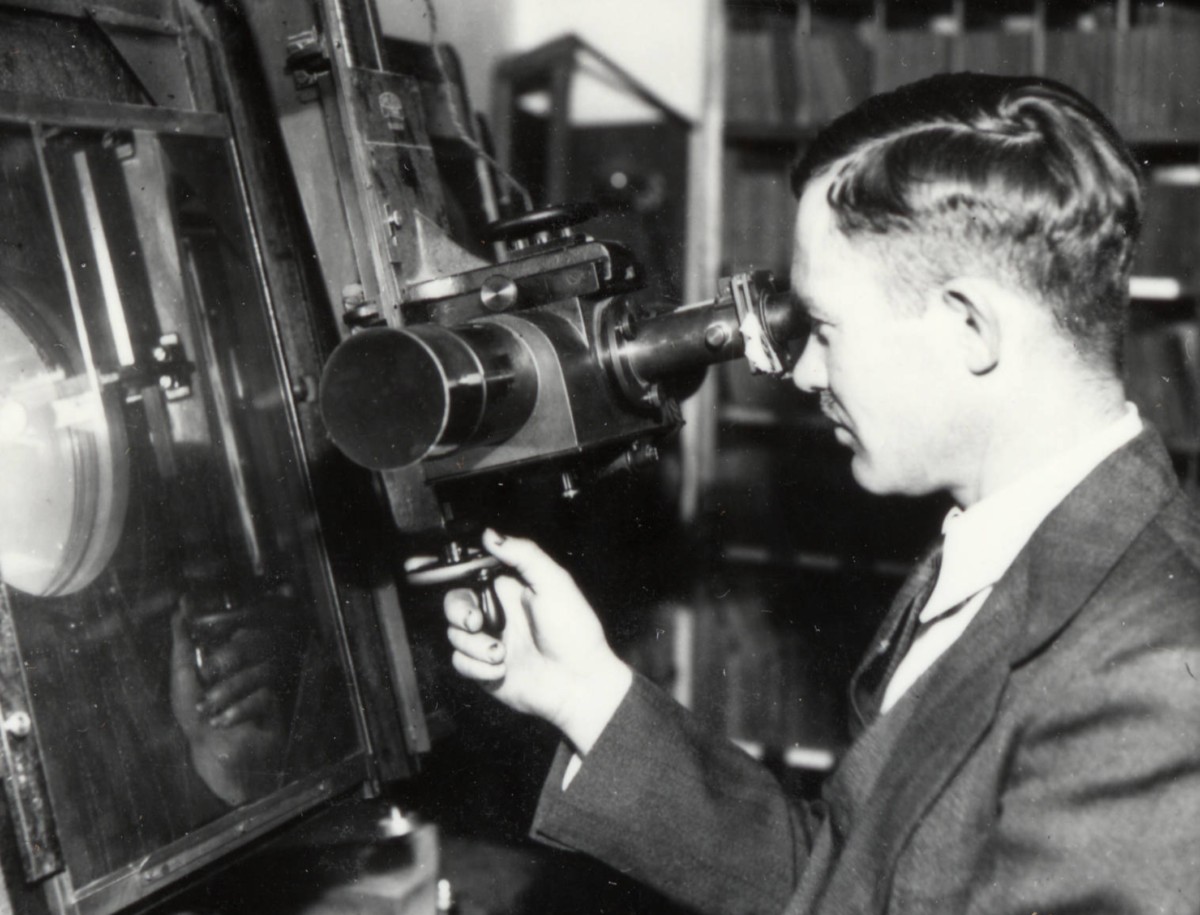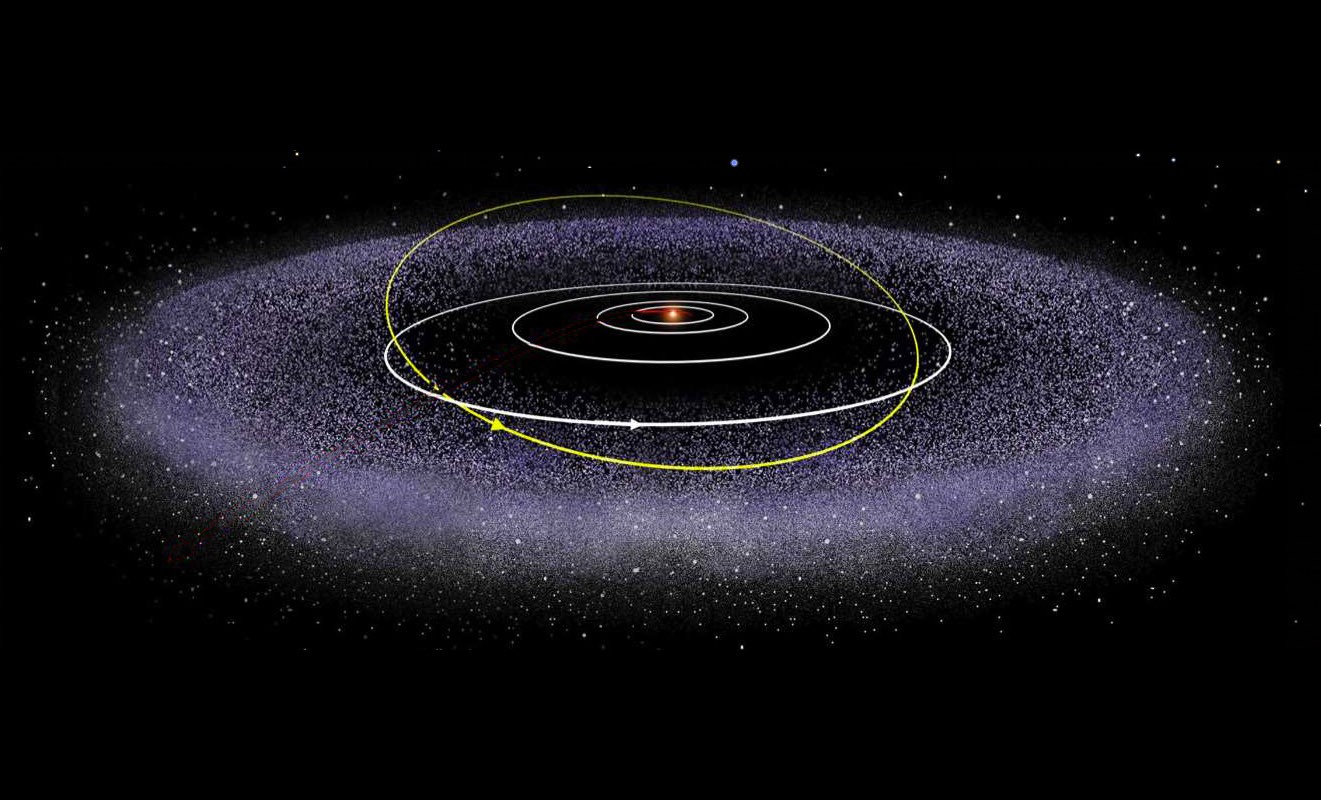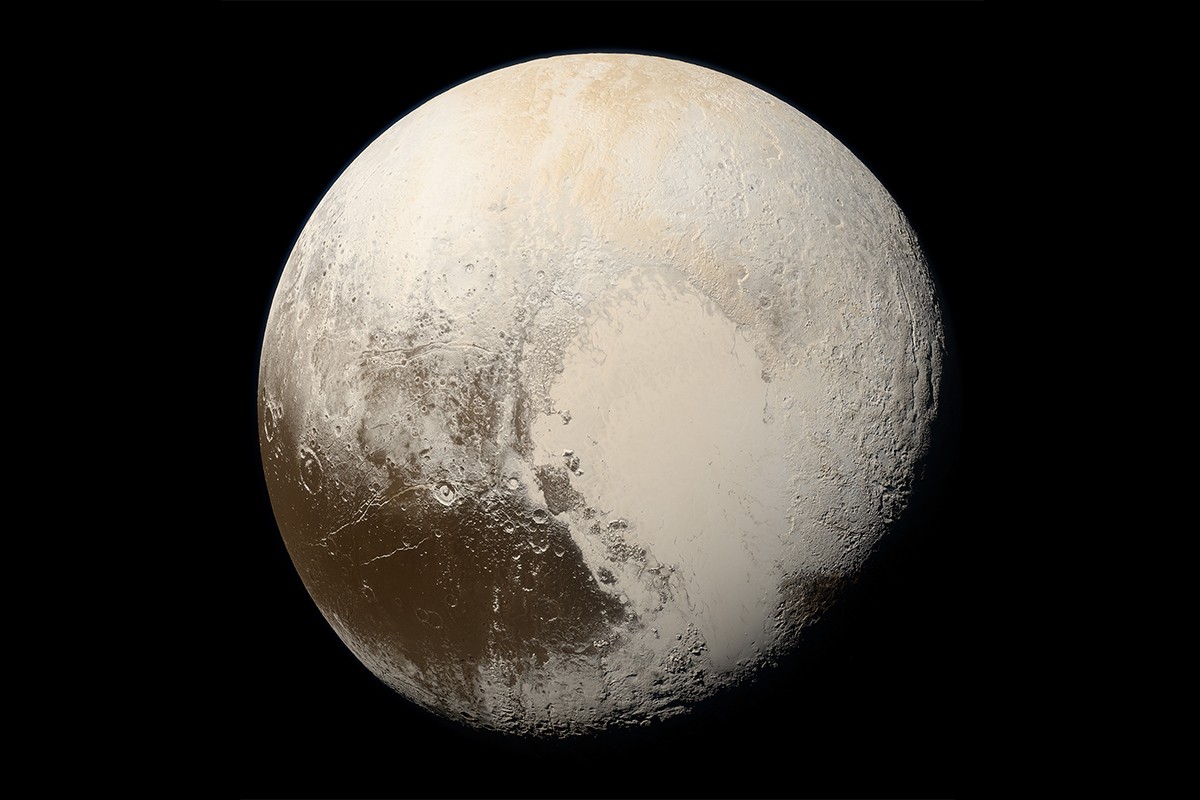Why Pluto Is Not A Planet is a question that has sparked debate and curiosity among space enthusiasts. At WHY.EDU.VN, we unravel this cosmic puzzle, exploring Pluto’s unique characteristics and its reclassification as a dwarf planet. Discover the reasons behind this controversial decision and deepen your understanding of our solar system, including Kuiper Belt Objects and planetary science.
1. Pluto’s Demotion: A Cosmic Controversy
On August 24, 2006, the International Astronomical Union (IAU) made a landmark decision: Pluto was no longer a planet. This wasn’t a snap judgment but the result of years of scientific debate and new discoveries that challenged our traditional understanding of what defines a planet. IAU Resolution 5A, officially titled ‘Definition of a Planet in the Solar System’, laid out the criteria that Pluto failed to meet, leading to its reclassification as a “dwarf planet.” This decision was met with mixed reactions, from disappointment and nostalgia to scientific acceptance and a renewed interest in the dynamics of our solar system.
1.1 The Historical Context: From Planet to Dwarf Planet
Pluto’s journey from the ninth planet to a dwarf planet is a story of scientific evolution. Initially hailed as the missing “Planet X,” its discovery in 1930 filled a perceived gap in our understanding of the solar system. However, as technology advanced and astronomers peered deeper into space, Pluto’s uniqueness began to stand out. Its small size, unusual orbit, and the discovery of other similar objects in the Kuiper Belt raised questions about its planetary status. This culminated in the IAU’s decision in 2006, marking a turning point in planetary science and forcing us to refine our definition of what constitutes a planet.
2. The Discovery of Pluto: A Serendipitous Find
The story of Pluto begins in the mid-17th century, a period marked by a scientific revolution. Johannes Kepler’s laws of planetary motion, coupled with Isaac Newton’s law of gravity, provided astronomers with unprecedented tools to predict the movements of celestial bodies. However, by the early 19th century, anomalies began to surface. Uranus, recently discovered, wasn’t behaving as expected, deviating from its predicted path.
2.1 The Uranus Anomaly and the Quest for Planet X
French astronomer Alexis Bouvard noted these discrepancies and theorized the presence of an unseen body influencing Uranus’s orbit. Independently, John Couch Adams and Urbain Le Verrier predicted the location of this new planet, leading to the discovery of Neptune in 1846 by Johann Galle and Heinrich d’Arrest. Despite this discovery, the Uranus anomaly persisted, sparking Percival Lowell’s interest. He established an observatory in Flagstaff, Arizona, in 1894, dedicating himself to finding “Planet X,” the hypothetical planet causing these orbital disturbances.
2.2 Clyde Tombaugh’s Breakthrough
After Lowell’s death in 1916, the search continued, eventually falling to Clyde Tombaugh in 1929. Tombaugh meticulously analyzed photographic plates taken of the sky, using a blink comparator to identify moving objects against the fixed background of stars. On February 18, 1930, his persistence paid off – he discovered a faint object moving among the stars of Gemini. This was Planet X, later named Pluto, fulfilling Lowell’s decades-long quest.
3. Pluto’s Characteristics: Unveiling a Unique World
Even after its discovery, doubts lingered about Pluto’s true nature. Its faintness and unresolved disc suggested a small size, casting doubt on its ability to significantly influence Uranus and Neptune. Despite these uncertainties, astronomers continued to study Pluto, gradually uncovering its unique characteristics.
3.1 Size and Composition
Observations revealed that Pluto was likely covered in methane-ice, a surface composition quite different from the gas giants and terrestrial planets of the inner solar system. The 1978 discovery of Charon, Pluto’s largest moon, by astronomer James Christy allowed for a more accurate estimation of Pluto’s mass. The results were surprising: Pluto was significantly smaller than previously thought, even smaller than Earth’s Moon.
3.2 Unveiling the Kuiper Belt
The 1990s brought a revolution in astronomical imaging with the advent of CCD cameras, far more sensitive than photographic film. These new tools allowed astronomers to peer deeper into the solar system, revealing a plethora of Pluto-sized objects beyond Neptune’s orbit. These objects belonged to the Kuiper Belt, a vast region of icy bodies left over from the solar system’s formation. Pluto, it turned out, was just one of the largest members of this belt. The discovery of other sizable Kuiper Belt Objects (KBOs) like Quaoar, Sedna, Makemake, and Eris further fueled the debate about Pluto’s planetary status.
4. The IAU Definition: Redefining a Planet
The growing number of KBO discoveries forced the International Astronomical Union (IAU) to confront the question: what exactly defines a planet? In 2006, the IAU established a formal definition, outlining three key criteria:
4.1 Three Criteria for Planetary Status
- The object must orbit the Sun directly.
- The object must be massive enough for its gravity to pull it into a nearly round shape (hydrostatic equilibrium).
- The object must have “cleared the neighborhood” around its orbit.
4.2 Pluto’s Failure to Clear Its Orbit
It was the third criterion that ultimately led to Pluto’s reclassification. “Clearing the neighborhood” means that the object must be gravitationally dominant in its orbit, either by absorbing or flinging away other objects. Pluto, due to its small size and shared orbital space with other KBOs, has not cleared its neighborhood. Therefore, according to the IAU definition, it could not be considered a planet.
5. The Dwarf Planet Designation: A New Category
Failing to meet the full criteria for planetary status, Pluto was reclassified as a “dwarf planet.” This new category recognized objects that met the first two criteria – orbiting the Sun and achieving hydrostatic equilibrium – but had not cleared their orbits. Other dwarf planets include Ceres, Eris, Makemake, and Haumea.
5.1 The Significance of Dwarf Planets
Despite the demotion, Pluto and other dwarf planets remain valuable subjects of scientific study. They offer insights into the early solar system and the processes that shaped the planets we know today. Their icy compositions and distant locations preserve clues about the conditions present during the solar system’s formation.
5.2 The New Horizons Mission: A Closer Look at Pluto
In 2015, NASA’s New Horizons spacecraft flew past Pluto, providing unprecedented images and data about this distant world. The mission revealed a complex and dynamic surface, with mountains, glaciers, and a surprisingly active geology. New Horizons’ findings further emphasized the scientific importance of Pluto and sparked renewed interest in dwarf planets and the Kuiper Belt.
6. Arguments for Pluto’s Planetary Status: A Continuing Debate
Despite the IAU’s decision, the debate about Pluto’s planetary status continues. Some astronomers and space enthusiasts argue that Pluto should still be considered a planet, citing various reasons:
6.1 The Sentimental Argument
Many people grew up learning that Pluto was the ninth planet, and its demotion feels like a loss. This sentimental attachment fuels the argument that Pluto should remain a planet out of tradition and respect for its historical significance.
6.2 Inconsistencies in the IAU Definition
Critics of the IAU definition point out inconsistencies in its wording. They argue that Earth and Jupiter, for example, have not fully cleared their orbits, as they share orbital space with asteroids. Earth orbits with thousands of near-Earth asteroids, while Jupiter has over 100,000 Trojan asteroids within its orbit. These critics argue that if “clearing the neighborhood” is strictly applied, Earth and Jupiter could also be disqualified as planets.
6.3 A Size-Based Definition
Another argument proposes a size-based definition of a planet, suggesting that any object orbiting the Sun with a surface area greater than 1,000 kilometers should be considered a planet. This definition would include Pluto and Eris, along with other large KBOs, expanding the number of planets in our solar system.
7. The Broader Implications: What It Means to Be a Planet
The Pluto debate raises fundamental questions about how we define and categorize celestial objects. It highlights the evolving nature of science and the importance of adapting our understanding as new discoveries are made.
7.1 The Importance of Clear Definitions
While sentiment and tradition are important, clear and consistent definitions are essential for scientific accuracy. The IAU definition provides a framework for classifying planets based on objective criteria, allowing for a more systematic understanding of the solar system and beyond.
7.2 The Diversity of Planetary Bodies
The Pluto debate also underscores the diversity of planetary bodies in our solar system. From the gas giants to the terrestrial planets to the dwarf planets, each type of object offers unique insights into the processes that shaped our cosmic neighborhood. By studying these diverse objects, we can gain a deeper understanding of planet formation, evolution, and the potential for life beyond Earth.
8. Exploring Pluto and Beyond: Continued Exploration
The story of Pluto is far from over. As technology advances and our understanding of the solar system deepens, we can expect further discoveries and revisions to our classifications. Future missions to Pluto and other KBOs will undoubtedly reveal new insights into these distant worlds, challenging our current understanding and inspiring future generations of scientists.
8.1 Potential Future Missions
Scientists have proposed various future missions to Pluto and the Kuiper Belt, including orbiters, landers, and sample return missions. These missions would provide more detailed information about the composition, geology, and atmosphere of Pluto and other KBOs, helping us to answer fundamental questions about the early solar system.
8.2 The Search for Planet Nine
The quest for “Planet X” may not be over either. Some astronomers continue to search for a hypothetical “Planet Nine,” a large, distant planet that could be influencing the orbits of certain KBOs. If discovered, Planet Nine would further expand our understanding of the outer solar system and the processes that shape planetary orbits.
9. Conclusion: A Dynamic and Evolving Understanding
Why Pluto is not a planet is a question that encapsulates the dynamic and evolving nature of scientific understanding. Pluto’s reclassification as a dwarf planet reflects our growing knowledge of the solar system and the need for clear and consistent definitions. While the debate may continue, Pluto remains a fascinating and important object of study, offering valuable insights into the formation and evolution of our cosmic neighborhood. At WHY.EDU.VN, we are committed to providing accurate and accessible information about the latest discoveries in astronomy and planetary science, helping you to explore the wonders of the universe.
9.1 Continuing the Quest for Knowledge
The story of Pluto reminds us that science is a continuous process of discovery, questioning, and revision. As we continue to explore the universe, we can expect further surprises and challenges to our current understanding. By embracing curiosity and critical thinking, we can unlock the secrets of the cosmos and deepen our appreciation for the beauty and complexity of the universe.
Are you still curious about Pluto or have other burning questions about space and science? Visit WHY.EDU.VN today at 101 Curiosity Lane, Answer Town, CA 90210, United States, or reach out to us on Whatsapp at +1 (213) 555-0101. Our team of experts is ready to provide you with detailed, easy-to-understand answers based on the latest research and insights. Don’t let your questions go unanswered – discover the universe with WHY.EDU.VN.
10. FAQ: Frequently Asked Questions About Pluto
Here are some frequently asked questions about Pluto and its reclassification as a dwarf planet:
| Question | Answer |
|---|---|
| Why was Pluto reclassified as a dwarf planet? | Pluto was reclassified because it does not “clear its neighborhood” of other objects in its orbit, a key criterion for being a planet according to the IAU. |
| What are the criteria for being a planet? | According to the IAU, a planet must orbit the Sun, be round due to its own gravity, and have cleared its orbital neighborhood. |
| What is a dwarf planet? | A dwarf planet orbits the Sun and is round due to its own gravity but has not cleared its orbital neighborhood. |
| Is Pluto still considered important for scientific study? | Yes, Pluto remains scientifically important as it provides insights into the early solar system and the Kuiper Belt. |
| What did the New Horizons mission reveal about Pluto? | The New Horizons mission revealed a complex and dynamic surface with mountains, glaciers, and active geology. |
| What is the Kuiper Belt? | The Kuiper Belt is a region beyond Neptune containing icy bodies, including Pluto and other dwarf planets. |
| Are there any arguments for Pluto being a planet? | Yes, some argue for Pluto’s planetary status based on sentimental reasons, inconsistencies in the IAU definition, and alternative size-based definitions. |
| What is the IAU? | The International Astronomical Union is the organization responsible for naming celestial bodies and resolving issues in astronomy. |
| Will Pluto ever be considered a planet again? | It is unlikely, unless the IAU changes its definition of a planet. |
| Where can I find more information about Pluto? | Visit why.edu.vn for detailed information and expert answers. Our address is 101 Curiosity Lane, Answer Town, CA 90210, United States, and you can reach us on Whatsapp at +1 (213) 555-0101. |



